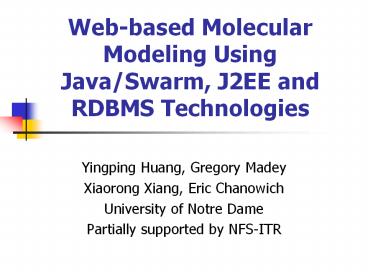Web-based Molecular Modeling Using Java/Swarm, J2EE and RDBMS Technologies - PowerPoint PPT Presentation
Title:
Web-based Molecular Modeling Using Java/Swarm, J2EE and RDBMS Technologies
Description:
Web-based Molecular Modeling Using Java/Swarm, J2EE and RDBMS Technologies Yingping Huang, Gregory Madey Xiaorong Xiang, Eric Chanowich University of Notre Dame – PowerPoint PPT presentation
Number of Views:121
Avg rating:3.0/5.0
Title: Web-based Molecular Modeling Using Java/Swarm, J2EE and RDBMS Technologies
1
Web-based Molecular Modeling Using Java/Swarm,
J2EE and RDBMS Technologies
- Yingping Huang, Gregory Madey
- Xiaorong Xiang, Eric Chanowich
- University of Notre Dame
- Partially supported by NFS-ITR
2
Research Area and Results
- The domain
- Scientific simulation
- Natural organic matter (NOM)
- Environmental biocomplexity
- The results A simulation model
- Agent-based using SWARM
- Stochastic
- Web-based J2EE, XML Oracle
- Load-balancing and fail-over enabled
- Data warehousing data mining features included
3
Motivation
- IT A fourth paradigm of scientific study? (J.
Gray, et al, 2002 Fox, 2002) - Three previous approaches to scientific research
- Observation theory
- Hypothesis experiment
- Computational X simulation
- Information technologies
- J2EE middleware XML
- Databases Data Warehouses
- Data Mining
- Visualization
- Statistical analysis
- Natural organic matter (NOM)
4
Natural Organic Matter
- NOM is ubiquitous in terrestrial, aquatic and
marine ecosystems - Results from breakdown of animal plant material
in the environment - Important role in processes such as
- compositional evolution and fertility of soil
- mobility and transport of pollutants
- availability of nutrients for microorganisms and
plant communities - growth and dissolution of minerals
- Important to drinking water systems
- Impacts drinking water treatment
- Impacts quality of well water
5
Background
- Compositional evolution of NOM is an interesting
problem - Important aspect of predictive environmental
modeling - Prior modeling work is often
- too simplistic to represent the heterogeneous
structure of NOM and its complex behaviors in
ecosystems (e.g., carbon cycling models) - too compute-intensive to be useful for
large-scale environmental simulations (e.g.,
molecular models employing connectivity maps or
electron densities) - Hence, a Middle Computational Approach is taken
- Agent-based stochastic
6
Modeling
- Object oriented Molecules and microbes are
objects - Molecules and microbes have attributes
- Heterogeneous mixture different attributes
- Molecules have behaviors (physical chemical
processes) - Behaviors are stochastically determined
- Dependent on the
- Attributes (intrinsic parameters)
- Environment (extrinsic parameters)
7
Modeling (cont)
- Objects of interest
- Macromolecular precursors large molecules
- Cellulose
- Proteins
- Lignin
- Micromolecules smaller molecules
- Sugars
- Amino acids
- Microbes
- Bacteria
- Fungi
8
Modeling (cont)
- Attributes
- Elemental composition
- Number of C, H, O, N, S and P atoms in molecule
- Functional group counts
- Double-bonds
- Ring structures
- Phenyl groups
- Alcohols
- Phenols, ethers, esters, ketones, aldehydes,
acids, aryl acids, amines, amides, thioethers,
thiols, phosphoesters, phosphates - The time the molecule entered the system
- Precursor type of molecule
- Cellulose, protein, lignin, etc
9
Modeling (cont)
- Behaviors (reactions and processes)
- Physical processes
- Adsorption (stick) to mineral surfaces
- Aggregation/micelle formation
- Transport downstream (surface water)
- Transport through porous media
- Chemical reactions
- Abiotic bulk reactions free molecules
- Abiotic surface reactions adsorbed molecules
- Extracellular enzyme reactions on large molecules
- Microbial uptake by small molecules
10
Modeling (cont)
- Environmental parameters
- Temperature
- pH
- Light intensity
- Simulation time
- Microbial activity
- Water flow rate/pressure gradient
- Oxygen density
11
GUI Animation
Black - No Adsorption Gray - Levels of
Adsorption Red - Lignins Blue - Proteins Green -
Cellulous Yellow - Reacted Orange - Adsorbed
12
NOM 1.0
- Loosely coupled distributed systems
- 5Application servers (OC4J Servers)
- 3 Database servers (Oracle Data Warehouse,
Standby Database) - Reports server (OC4J Server/Reports Server)
- Load balancing (implemented by JMS, AQ and MDB)
- application servers
- Fail over
- application servers database servers
- Multi-master replication of important tables
- Why fail-over (Assume down probability p for each
machine) - No fail-over
- Simulation system down probability 1-(1-p)2
2p-p2 - With fail-over
- Simulation system down probability
1-(1-p5)(1-p2) p2 p5 p7 - Improvement
- 2/p 200 if p0.01 (the smaller p, the larger
improvement)
13
Sample Reports
14
Data Warehousing Star Schema
USERS DIMENSION user_id first_name last_name phon
e email password
MOLECULES DIMENSION molecule_id c h doublebond am
ines prob_0
REACTIONS user_id session_id molecule_id reaction
_type environment_id xpos ypos timestamp
ENVIRONMENT DIMENSION environ_id temperature md f
d pH
SESSIONS DIMENSION session_id user_id sid status
expected
REACTIONTYPE DIMENSION reaction_type reaction_nam
e
15
Data Mining Applying Clustering
- Model-build data format
- A table POINTS with attributes x y
- Points are chosen from the data warehouse
- Standardized x y are in 0,1)
- 16 million records
- Clusters explanation
- Dense areas in soil or solution
- Emerging behavior of random molecules (e.g.
Micelles)
16
Summary
- Contributions are
- New models which treats NOM as a heterogeneous
mixture using SWARM - Simulation system with advanced web database
tools J2EE, XML Oracle - System aspects of implementation of
load-balancing and fail-over using JMS, AQ, MDB,
JTA, etc. - Data warehousing for simulation data and
experimental data - Applying data mining to simulation data and
experimental data

